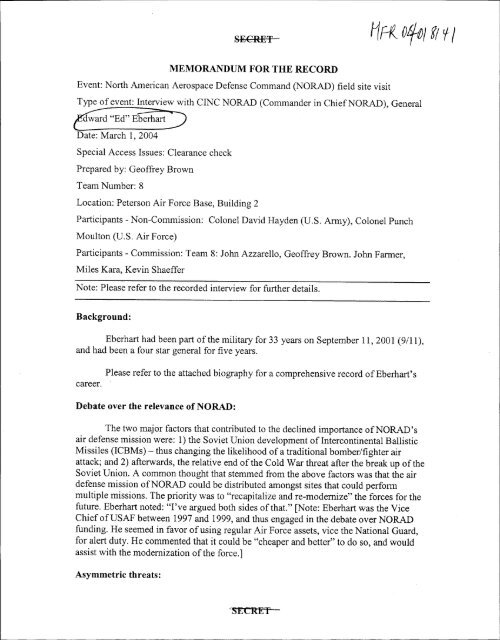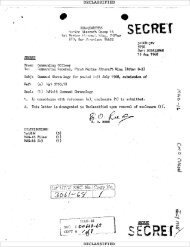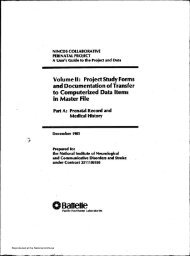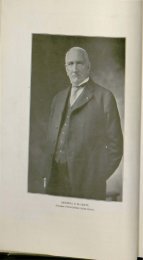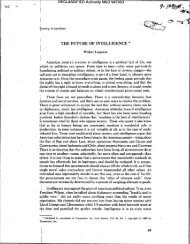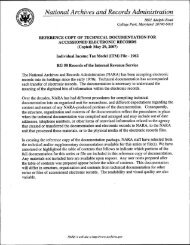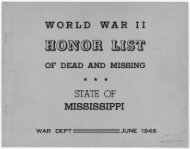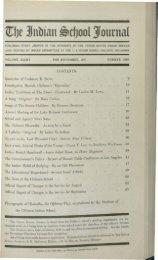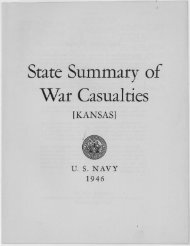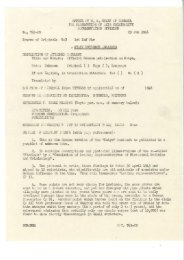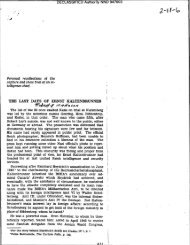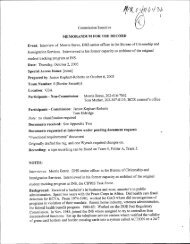Memorandum for the Record: Interview With CINC NORAD
Memorandum for the Record: Interview With CINC NORAD
Memorandum for the Record: Interview With CINC NORAD
Create successful ePaper yourself
Turn your PDF publications into a flip-book with our unique Google optimized e-Paper software.
SECRET<br />
MEMORANDUM FOR THE RECORD<br />
Event: North American Aerospace Defense Command (<strong>NORAD</strong>) field site visit<br />
Type of event: <strong>Interview</strong> with <strong>CINC</strong> <strong>NORAD</strong> (Commander in Chief <strong>NORAD</strong>) , General<br />
~ "Ed" Eberhart:J<br />
Date: March 1, 2004<br />
Special Access Issues: Clearance check<br />
Prepared by: Geoffrey Brown<br />
Team Number: 8<br />
Location: Peterson Air Force Base, Building 2<br />
Participants - Non-Commission: Colonel David Hayden (U.S. Army), Colonel Punch<br />
Moulton (U.S. Air Force)<br />
Participants - Commission: Team 8: John Azzarello, Geoffrey Brown. John Farmer,<br />
Miles Kara, Kevin Shaeffer<br />
Note: Please refer to <strong>the</strong> recorded interview <strong>for</strong> fur<strong>the</strong>r details.<br />
Background:<br />
Eberhart had been part of <strong>the</strong> military <strong>for</strong> 33 years on September 11,2001 (9/11),<br />
and had been a four star general <strong>for</strong> five years.<br />
career.<br />
Please refer to <strong>the</strong> attached biography <strong>for</strong> a comprehensive record of Eberhart's<br />
Debate over <strong>the</strong> relevance of <strong>NORAD</strong>:<br />
The two major factors that contributed to <strong>the</strong> declined importance of<strong>NORAD</strong>'s<br />
air defense mission were: 1) <strong>the</strong> Soviet Union development of Intercontinental Ballistic<br />
Missiles (ICBMs) - thus changing <strong>the</strong> likelihood of a traditional bomber/fighter air<br />
attack; and 2) afterwards, <strong>the</strong> relative end of <strong>the</strong> Cold War threat after <strong>the</strong> break up of <strong>the</strong><br />
Soviet Union. A common thought that stemmed from <strong>the</strong> above factors was that <strong>the</strong> air<br />
defense mission of<strong>NORAD</strong> could be distributed amongst sites that could per<strong>for</strong>m<br />
multiple missions. The priority was to "recapitalize and re-modernize" <strong>the</strong> <strong>for</strong>ces <strong>for</strong> <strong>the</strong><br />
future. Eberhart noted: "I've argued both sides of that." [Note: Eberhart was <strong>the</strong> Vice<br />
Chief of USAF between 1997 and 1999, and thus engaged in <strong>the</strong> debate over <strong>NORAD</strong><br />
funding. He seemed in favor of using regular Air Force assets, vice <strong>the</strong> National Guard,<br />
<strong>for</strong> alert duty. He commented that it could be "cheaper and better" to do so, and would<br />
assist with <strong>the</strong> modernization of <strong>the</strong> <strong>for</strong>ce.]<br />
Asymmetric threats:
Eberhart commented that prior to 9111 asymmetric threats were seen as part of<br />
national security's "away game" instead of its "home game". These threats included<br />
cruise missiles, weapons of mass destruction (WMDs), or computer systems threats.<br />
Though <strong>the</strong> classic attrition warfare ascribed to <strong>the</strong> Cold War was unlikely, asymmetric<br />
threats were not scene as a domestic priority <strong>for</strong> <strong>NORAD</strong>. Most thoughts on domestic<br />
terrorism were tied to <strong>the</strong> circumstance of <strong>the</strong> Oklahoma City bombing, and thus a law<br />
en<strong>for</strong>cement issue.<br />
<strong>NORAD</strong> considered itself least prepared to respond to cruise missiles during <strong>the</strong><br />
Soviet era. Afterwards, with <strong>the</strong> disbanding of <strong>the</strong> Soviet Union, as stockpiles of weapons<br />
were less stringently monitored, and as <strong>the</strong> technology to create a "poor man's" cruise<br />
missile became disseminated, <strong>NORAD</strong> considered it possible <strong>for</strong> terrorist organizations<br />
to employ cruise missiles. This was <strong>NORAD</strong>'s primary terrorist-related concern.<br />
Air Sovereignty in name only:<br />
Eberhart commented that he held <strong>the</strong> same concerns as General Myers upon his<br />
ascendancy to <strong>the</strong> position of <strong>CINC</strong> <strong>NORAD</strong>, which included <strong>the</strong> notion that <strong>NORAD</strong><br />
could only provide "token sovereignty" <strong>for</strong> CONUS· airspace. Mainly, <strong>the</strong> ability to have<br />
air traffic control and aerospace control was undergoing a process of atrophy. He<br />
commented that it was very difficult to express <strong>the</strong> importance of <strong>the</strong> threat be<strong>for</strong>e 9/11.<br />
They developed a NAASC (North American Air Surveillance Council) ef<strong>for</strong>t to address<br />
this concern.<br />
The NAASC was able to stop an FAA proposal to disable <strong>the</strong> ability to track<br />
primary targets on radar, and <strong>NORAD</strong>IF AA attempted to create a funding-sharing<br />
arrangement. The money was allotted with <strong>the</strong> assumption that GPS (global positioning<br />
satellite) technology would replace <strong>the</strong> radar technology. Eberhart stated that <strong>NORAD</strong><br />
went on record, via <strong>the</strong> NAASC, <strong>for</strong> <strong>the</strong> need to share <strong>the</strong> air survellaince financial<br />
burden across <strong>the</strong> DoD (Department of Defense) and <strong>the</strong> DoT (Department of<br />
Transportation). He commented: "<strong>With</strong>out 9/11 we would have likely lost that fight.<br />
Everyone agreed, but didn't want to pay <strong>for</strong> it or thought that new technology would<br />
come online" to replace <strong>the</strong> technical difficulties. Succinctly, Eberhart opined that if 9/11<br />
had not occurred <strong>the</strong>re would have been no financial will to pay <strong>for</strong> new radar capability.<br />
Joint FAAJ<strong>NORAD</strong> training:<br />
Eberhart commented that prior to 9/11 <strong>the</strong>re was not much interest between <strong>the</strong><br />
FAA and <strong>NORAD</strong> to share in exercises. The FAA priority was to serve <strong>the</strong> economic<br />
needs of <strong>the</strong> air traffic, whereas <strong>NORAD</strong> at times would be seen by <strong>the</strong> FAA as<br />
infringing on this priority by <strong>the</strong> use of space in exercises.<br />
Eberhart noted that prior to 9111 <strong>the</strong> role of <strong>the</strong> FAA in national security was to<br />
vector <strong>NORAD</strong> assets towards a target inbound to <strong>the</strong> Continental United States<br />
(CONUS).<br />
--SECRET
Law en<strong>for</strong>cement events:<br />
Eberhart noted that <strong>the</strong> role of<strong>NORAD</strong> in CONUS events is to respond in support<br />
of <strong>the</strong> lead federal agency, just as <strong>the</strong> National Guard, as part of <strong>the</strong> military, supports law<br />
en<strong>for</strong>cement in certain events.<br />
<strong>NORAD</strong>'s external focus can be attributed partially to no documented indication<br />
of a threat akin to <strong>the</strong> 9111 attacks having reached a <strong>CINC</strong> <strong>NORAD</strong>.<br />
Matrix of primary threats pre-9f11:<br />
One of <strong>the</strong> primary threats Eberhart was aware of pre-9lll was <strong>the</strong> "slim chance"<br />
that <strong>the</strong> politico-military events in Russia would destabilize to <strong>the</strong> point at which an<br />
attack would be initiated. This possibility necessitated constant vigilance over <strong>the</strong> ADIZ<br />
(Air Defense Identification Zones).<br />
A threat that was given priority at <strong>NORAD</strong> also was its important role as <strong>the</strong> eyes<br />
and ears of <strong>the</strong> U.S. external drug mission. The primary difference between <strong>NORAD</strong>'s<br />
projected missions and <strong>the</strong> 9111 attacks, according to Eberhart, was that in fulfilling<br />
<strong>NORAD</strong>'s air sovereignty and defense missions, whe<strong>the</strong>r in support of o<strong>the</strong>r U.S.<br />
agencies or not, <strong>the</strong> threats <strong>NORAD</strong> was tasked with always originated from outside of<br />
CONUS. There<strong>for</strong>e, in <strong>the</strong>se circumstances <strong>the</strong>re was more time to respond to <strong>the</strong> event.<br />
Eberhart commented that <strong>NORAD</strong> had never "set up" a CAP (Combat Air Patrol)<br />
program prior to 9/11 because it was an impractical tactic to respond to <strong>the</strong> types of air<br />
threats <strong>NORAD</strong> was tasked with defending against. A CAP would not be a practical<br />
defense against long range air-to-surface missiles. The only practical and developed<br />
response would have been that which <strong>NORAD</strong> practiced <strong>for</strong> - to neutralize <strong>the</strong> ICBM's<br />
airborne delivery system be<strong>for</strong>e launch. Fur<strong>the</strong>r, Eberhart noted that <strong>the</strong> mission to<br />
intercept an airborne intercontinental threat at .8 mach does not translate to <strong>the</strong> law<br />
en<strong>for</strong>cement mission that has now been tasked to <strong>NORAD</strong> by <strong>the</strong> President.<br />
Regarding <strong>the</strong> FAA's role in air defense, Eberhart noted that he believes <strong>the</strong> FAA<br />
thought 1) airport security would have been more robust; and 2) that any hijack would<br />
have been a "classic" hij ack. Both <strong>the</strong>se misconceptions led to <strong>the</strong>ir lack of preparedness<br />
on 9/11.<br />
Moving towards 9/11 in history:<br />
Eberhart explained that it quickly became obvious to him after <strong>the</strong> fall of <strong>the</strong><br />
Soviet Union, through <strong>the</strong> old Warsaw pact posturing and <strong>the</strong> "saber rattling" of Sadaam<br />
Hussein, that <strong>the</strong> world was "far more dangerous" than it had been. But because of <strong>the</strong><br />
separation of <strong>the</strong> ocean from <strong>the</strong>se threats, Eberhart had always viewed <strong>the</strong> military as<br />
fighting an "away game" in <strong>the</strong> Middle East and in Eastern Europe. When he came to<br />
<strong>NORAD</strong> in 2000, he was concerned with ballistic missile defense. He was also concerned<br />
-8ECItE!J:.
•<br />
•<br />
•<br />
with "finding a way ahead with cruise missile defense", and stopping <strong>the</strong> atrophy of <strong>the</strong><br />
radar capability.<br />
Eberhart commented to Commission staff that he sti 11does not know "exactly<br />
what <strong>the</strong> intelligence community had" regarding <strong>the</strong> possibility of an attack like that of<br />
9111, but if <strong>the</strong> intelligence community had had in<strong>for</strong>mation that postulated a terrorist<br />
group would attack an urban setting with an aircraft, <strong>the</strong>n that in<strong>for</strong>mation would been<br />
passed to <strong>NORAD</strong>. Fur<strong>the</strong>r, according to Eberhart, <strong>NORAD</strong> did postulate an air attack<br />
from abroad prior to 9/11, but in all <strong>the</strong> proposed scenarios: 1) <strong>the</strong> aircraft would be<br />
squawking; 2) <strong>the</strong> airline pilots would be in cockpit control, not <strong>the</strong> terrorists; and 3)<br />
<strong>NORAD</strong> would have a substantial period of time to react, and to pass ROE through <strong>the</strong><br />
appropriate National Command Authority.<br />
The Russian threat re-emergent:<br />
9/11 :<br />
9/11 Classified In<strong>for</strong>mation<br />
Eberhart received a call at 6:45AM MDT (Mountain Daily Time, or 8:45AM<br />
EST) from CMOC's Command Director (CD) that in<strong>for</strong>med him of <strong>the</strong> ongoing<br />
circumstance of a suspected hijacking on <strong>the</strong> East Coast. He was told that this was a nonexercise.<br />
He went to his office, and saw <strong>the</strong> CNN broadcast of <strong>the</strong> World Trade Center<br />
explosion. He asked if <strong>the</strong> aircraft that was suspected of impacting <strong>the</strong> World Trade<br />
Center was <strong>the</strong> same aircraft that was a suspected hijack, and was told that <strong>the</strong>y were not.<br />
Eberhart commented that <strong>the</strong>re was apparently "great confusion in <strong>the</strong> system". After <strong>the</strong><br />
second impact, it was "obvious" to Eberhart that <strong>the</strong>re was an ongoing and coordinated<br />
terrorist attack. He attempted to contact <strong>the</strong> Chairman of <strong>the</strong> Joint Chiefs of Staff (CJCS),<br />
but was unable since <strong>the</strong> CJCS was airborne at <strong>the</strong> time. So he immediately contacted<br />
higher command authority at <strong>the</strong> Pentagon. Eberhart stayed at Building 1 (US Space<br />
Command, which he was also <strong>the</strong> Commander of), since he did not want to loose<br />
communication. He went to <strong>the</strong> Cheyenne Mountain Operations Center (CMOC) later in<br />
<strong>the</strong> morning.<br />
After Otis ANGB scramble:<br />
Eberhart had trust in <strong>the</strong> commanders of <strong>the</strong> sectors and <strong>the</strong> authority at CONR,<br />
and thus had no involvement with vectoring <strong>the</strong> fighters. He did note that ifhe heard<br />
(while monitoring <strong>the</strong> decisions of his commanders) an order he did not agree with, he<br />
would counter <strong>the</strong> order; but <strong>for</strong> most incidents he has confidence in his commanders. He<br />
noted that in cross-border operations he takes more of C:Ul active role.<br />
Eberhart stayed in communication with General Myers. He believes he moved his<br />
operations to Cheyenne Mountain at approximately 9:30EMT. He believes that as he was
SECRET<br />
traveling while both Delta 1989 and United Airlines Flight 93 (UAL 93) were ongoing<br />
events. He believes he reported to Cheyenne Mountain as UAL 93 was ongoing.<br />
Langley at Battle Stations:<br />
Eberhart noted that on his communication loop it had "quieted down" be<strong>for</strong>e he<br />
made <strong>the</strong> decision to go to <strong>the</strong> Mountain.<br />
Langley scramble and <strong>the</strong> rebirth of AA 11:<br />
Eberhart had no knowledge of <strong>the</strong> circumstance that initiated <strong>the</strong> scramble of <strong>the</strong><br />
Langley fighters. He was only made aware of <strong>the</strong> circumstance recently. [Note:<br />
Commission staff believes that a false rumor that AA 11 was still airborne after 8:46AM<br />
and headed en route to Washington, D.C. was <strong>the</strong> cause <strong>for</strong> <strong>the</strong> Langley scramble. This is<br />
evident through analysis of <strong>the</strong> NEADS Mission Crew Commander recording from<br />
position 2 - MCC Op 2.]<br />
Threat to Chicago:<br />
Eberhart recalls concern over responding with capable assets to an aircraft that<br />
was reported headed towards Chicago. Eberhart in<strong>for</strong>med Commission staff that he<br />
believed <strong>the</strong> Sears Tower was a likely target.<br />
American Airlines Flight 77 (AA 77):<br />
Eberhart recalls that General Arnold gave in<strong>for</strong>mation that a plane "might have<br />
been" in <strong>the</strong> vicinity of Washington, D.C.<br />
Authority <strong>for</strong> Fighter Intercept Order (AFIO):<br />
Eberhart had no comment on <strong>the</strong> Langley fighters AFIO (Quad 7s) declaration,<br />
and only noted that when a fighter achieves certain levels of mach <strong>the</strong> weaponry on <strong>the</strong><br />
fighters may not work upon arrival to a target.<br />
Delta 1989 and <strong>the</strong> circumstance with VAL 93:<br />
Commission staff represented to Eberhart partial results of its investigation.<br />
Eberhart commented that Delta 1989 and UAL 93 may have been interchanged. He<br />
commented that he understands that <strong>the</strong>re is "support" <strong>for</strong> this <strong>the</strong>ory.<br />
Vice President's order:<br />
Eberhart noted that <strong>the</strong> VP order occurred slightly prior to his arrival at <strong>the</strong><br />
mountain. He noted that he indicated by <strong>the</strong> way <strong>the</strong> order was input through <strong>the</strong> system<br />
that <strong>the</strong> airliner would have to display a "hostile act" be<strong>for</strong>e <strong>the</strong> order <strong>for</strong> a shoot down<br />
would occur. Eberhart believes that General Findley in<strong>for</strong>med him of <strong>the</strong> VP order. He<br />
-SECRET
-SECRE'f' .......<br />
reacted that to shoot-down an airplane based on its location was an extreme act. He noted<br />
that <strong>the</strong> order had already been communicated down chain, so he communicated to<br />
Continental United States Aerospace Defense Region (CONR) that <strong>the</strong>y should still look<br />
<strong>for</strong> a hostile act. He .viewed his direction as specificity, not countermanding. Eberhart<br />
noted that <strong>the</strong> burden of making <strong>the</strong> decision to pass an order authorizing <strong>the</strong> engagement<br />
of a commercial airliner "pales in comparison to <strong>the</strong> burden on <strong>the</strong> person who would<br />
pull <strong>the</strong> trigger" - Eberhart used this comment to indicate that he understands that <strong>the</strong>re is<br />
"no one who wants to do this less than <strong>the</strong> fighter pilot". He commented that if <strong>the</strong> pilot<br />
saw "<strong>the</strong> nose down, no landing gear, high speed" - <strong>the</strong>n this could be construed as a<br />
hostile act; but no matter what <strong>the</strong> circumstance, <strong>the</strong> pilot would look towards his<br />
command <strong>for</strong> an indication of what to do.<br />
Eberhart assumed that <strong>the</strong> order was passed to <strong>the</strong> level of <strong>the</strong> fighter pilot. "Rules<br />
of engagement are only good if those engaged know <strong>the</strong> rules".<br />
Eberhart spent time in <strong>the</strong> days <strong>the</strong>reafter 9111 on ef<strong>for</strong>ts to <strong>for</strong>mulate proper and<br />
<strong>for</strong>mal specificity of ROE to be passed to his commands.<br />
Weapons-free:<br />
Eberhart noted that General Worley did not have <strong>the</strong> authority to give a<br />
"weapons- free" order. Eberhart commented that a <strong>NORAD</strong> pilot is not under Worley's<br />
command, and thus would not operate under that order. Fur<strong>the</strong>r, <strong>the</strong> Andrews pilots under<br />
Worley's command should have known that Worley did not have that authority, and thus<br />
would ideally have still looked towards a higher command authority <strong>for</strong> specificity and<br />
direction.<br />
Eberhart commented that a fighter pilot is trained only to become weapons- free<br />
after a hostile target is identified.<br />
Eberhart noted that <strong>the</strong> fighters' command and control (C2) through NEADS<br />
rested on his authority; whereas <strong>the</strong> air traffic control of <strong>the</strong> fighters rested with <strong>the</strong> FAA.<br />
Eberhart noted that despite <strong>the</strong> communication difficulties <strong>the</strong>re is almost always a way<br />
to communicate through relays to <strong>the</strong> fighter pilots.<br />
DEFCON 3 declaration:<br />
Eberhart explained that <strong>the</strong>re was a debate over <strong>the</strong> advantages and disadvantages<br />
of declaring DEFCON 3, and believes <strong>the</strong> Pentagon initiated <strong>the</strong> DEFCON 3 transition.<br />
Eberhart commented that DEFCON 3 was not intended <strong>for</strong> <strong>the</strong> attacks of 9/11, and thus<br />
could have complicated <strong>the</strong> response to <strong>the</strong> attacks. Eberhart did not think it would have<br />
"done anything <strong>for</strong> us" within CONUS. [Commission staff believes General Myers was<br />
responsible <strong>for</strong> DEFCON 3 in order to increase <strong>the</strong> readiness posture of U.S. global<br />
<strong>for</strong>ces in light of <strong>the</strong> possibility that <strong>the</strong> CONUS attacks would be followed by attacks on<br />
u.s. <strong>for</strong>ces abroad.]<br />
,SECRET
•<br />
•<br />
'SECRET-<br />
Eberhart commented that "Transition ROE didn't change what we had already<br />
told <strong>the</strong>m (pilots)". [According to <strong>the</strong> Langley pilots' Commission interview Transition<br />
ROE certainly had a significant effect on <strong>the</strong>ir thought process.]<br />
Post-9f11 :<br />
9/11 Classified In<strong>for</strong>mation<br />
Eberhart noted that <strong>the</strong> events of 9/1 J were discussed at <strong>the</strong> tactical, strategic and<br />
operational levels of <strong>NORAD</strong>. Time-distance warning was recognized as a factor that<br />
"complicated <strong>the</strong> day"; which led to <strong>the</strong> DEN line, liaisons between <strong>the</strong> FAA and <strong>the</strong><br />
military and greater radar inter-operability. Fur<strong>the</strong>r, <strong>the</strong> alert base missions were<br />
evaluated in conjunction with key infrastructure and major population centers. Certain<br />
"air defense levels" were developed that could be implemented within time intervals<br />
(twenty minutes being <strong>the</strong> quickest possible escalation of an air defense level). This led to<br />
recommendations towards "tiered air defense alert levels" - levels that serve a long tenn<br />
goal <strong>for</strong> appropriate responses provided to <strong>the</strong> president given escalating air defense<br />
threats.<br />
Eberhart noted that it is necessary <strong>for</strong> <strong>the</strong> data link system - which allows <strong>for</strong><br />
target identification to be passed from one ill system to ano<strong>the</strong>r - to be implemented<br />
directly from <strong>the</strong> FAA to NEADS, and from NEADS to thy intercepting fighter aircraft.<br />
Timelines of events on 9/11:<br />
According to Eberhart, <strong>the</strong> timelines developed <strong>for</strong> <strong>NORAD</strong> of <strong>the</strong> 9111 attacks<br />
indicate that <strong>the</strong>re were difficulties with notification and with communicating rules of<br />
engagement (ROE). Eberhart commented that though those timelines "were not 'exactly<br />
correct" <strong>the</strong>y were used to address <strong>the</strong> operational faults of <strong>the</strong> day.<br />
Eberhart stated that in "no way" were <strong>the</strong> timelines created as a "falsification of<br />
<strong>the</strong> truth", and that <strong>the</strong>y were compiled with best intent. Commission staff represented to<br />
Eberhart <strong>the</strong> timeline facts that have been cornpi led by its research. Eberhart, after being<br />
presented with <strong>the</strong>se facts, commented that he does not know who was tasked with<br />
compiling <strong>the</strong> timelines <strong>for</strong> <strong>NORAD</strong>, and that whenever <strong>NORAD</strong> is shown that <strong>the</strong>re is<br />
something wrong with <strong>the</strong> timeline, <strong>the</strong>y adjust it. He commented that "no one has ever
discussed that with me be<strong>for</strong>e", regarding <strong>the</strong> differences between <strong>the</strong> <strong>NORAD</strong> official<br />
timeline and <strong>the</strong> facts uncovered by Commission staff. [Note: Upon fur<strong>the</strong>r interviews at<br />
<strong>NORAD</strong>, Commission staff learned that Eberhart was briefed on <strong>the</strong> <strong>NORAD</strong> time line in<br />
advance of Commission interviews, and this briefing was based on <strong>the</strong> time line delivered<br />
to Commission staff on February 23,2004. Eberhart denied in <strong>the</strong> course of this interview<br />
that he had ever been exposed to <strong>the</strong> a<strong>for</strong>ementioned timeline.]<br />
Eberhart also stated that <strong>the</strong> newest <strong>NORAD</strong> time line [delivered to Commission<br />
staff on February 23,2004] was likely <strong>the</strong> result of his "standing order" to correct <strong>the</strong><br />
record of events whenever possible.<br />
Commission May 2003 Hearing:<br />
Eberhart reviewed <strong>the</strong> prepared statement prior to it being sent to <strong>the</strong><br />
Commission. He has also reviewed a transcript of <strong>the</strong> hearing, but said he had no role in<br />
creating <strong>the</strong> time line that was presented. Eberhart stated that he spoke with General<br />
McKinley following <strong>the</strong> hearing, and was not pleased with <strong>the</strong> hearing.<br />
Recommendations:<br />
Eberhart stated that <strong>the</strong> "biggest challenge right now is what are <strong>the</strong>y (terrorists)<br />
thinking about doing that we're not practicing <strong>for</strong> or equipped <strong>for</strong>". Eberhart commented<br />
that within that challenge <strong>the</strong>re is a dilemma between confidence <strong>for</strong> <strong>the</strong> American<br />
people, deterrence against <strong>the</strong> aggressor, and <strong>the</strong> ground truth of capability.<br />
Eberhart also noted that he has concerns over a "complacent crew" who might<br />
have terrorist intentions.<br />
Eberhart believes that <strong>the</strong> ef<strong>for</strong>t to unify <strong>the</strong> language between <strong>the</strong> FAA and<br />
<strong>NORAD</strong> has been successful. He is worried however that over time this relationship may<br />
become less proactive.<br />
Eberhart commented that <strong>the</strong> National Guard ownership of <strong>the</strong> <strong>NORAD</strong> mission<br />
is appropriate, and that <strong>the</strong>re is no reason to move <strong>the</strong> mission back to <strong>the</strong> active duty<br />
military. Eberhart noted that <strong>for</strong> <strong>the</strong> "budgeted years" <strong>the</strong>re is enough resource to execute<br />
<strong>the</strong> current <strong>NORAD</strong> mission.<br />
Eberhart commented that he has found <strong>the</strong> quality of <strong>the</strong> intelligence in<strong>for</strong>mation<br />
sharing to be "very good". He has found great value in interrogation of terrorists at<br />
Guantanamo Bay and in law en<strong>for</strong>cement intelligence sharing.<br />
Eberhart commented that he knows of no need from <strong>NORAD</strong> <strong>for</strong> a change in<br />
Posse Comitatus, but that if a need presented itself <strong>the</strong>n it will be changed.<br />
Eberhart commented that <strong>the</strong>re is currently a scramble plan that has been<br />
developed so that fighter pilots know exactly how to reach <strong>the</strong> likely air patrol areas<br />
-SECRET
-sECRET<br />
unless <strong>the</strong>y are paired with a specific target. These ef<strong>for</strong>ts have been coordinated with <strong>the</strong><br />
FAA.<br />
Eberhart "personally thinks" that <strong>the</strong> ground to air defense measures that are in<br />
place currently are appropriate, and that <strong>the</strong> ef<strong>for</strong>ts made to implement such measures on<br />
individual event bases are ongoing, considered <strong>for</strong> each event, and also appropriate.<br />
9/11 in American history:<br />
Eberhart commented that he hopes that in <strong>the</strong> future <strong>the</strong> war on terrorism will be<br />
won, and that <strong>the</strong>re will be no animosity to a specific ethnicity. He believes that <strong>the</strong> U.S.<br />
will know it has won when <strong>the</strong> roots - poverty and unemployment - of <strong>the</strong> problems that<br />
spawn terrorism are attacked.<br />
Follow. up:<br />
Eberhart was not aware that <strong>NORAD</strong> issued <strong>the</strong> Commission a new time line after<br />
its CONR interviews. Eberhart reviewed General Arnold and Colonel Scott's prepared<br />
statements <strong>for</strong> <strong>the</strong> Commission hearing in May of2003. General McKinley briefed<br />
Eberhart on <strong>the</strong> hearing. Eberhart did not focus or participate in any high level<br />
reconstruction of <strong>the</strong> attacks <strong>for</strong> review and release to <strong>the</strong> American public immediately<br />
<strong>the</strong>reafter 9/11. He answered Commission staff that he was not involved in any ef<strong>for</strong>t to<br />
"spin" <strong>the</strong> events of 9/11. Eberhart answered Commission staff that <strong>the</strong>re is no reason in<br />
his knowledge that Commander Marr would not represent <strong>the</strong> ground facts of <strong>the</strong> 9/11<br />
attacks.<br />
-SECRET -


